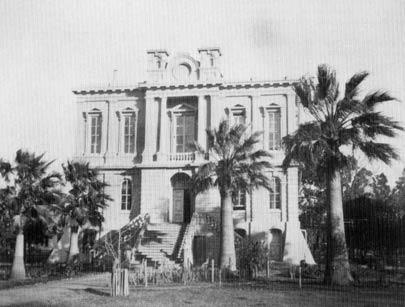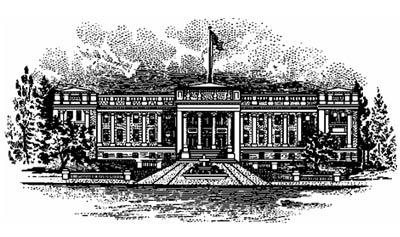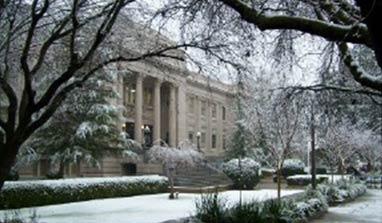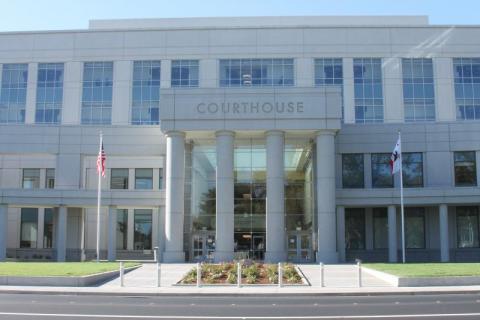History of the Yolo County Courthouse
Yolo County Courthouse 1864
Every historical building has a story behind it, and the previous Yolo County Courthouse is no exception. The original courthouse, shown below, was completed in 1864, ironically the same year William H. Weeks, the designer of the previous existing courthouse, was born in Canada.

On June 11, 1862, Franklin S. Freeman, a local landowner, and businessman and considered the founder of the City of Woodland, deeded a city block for $300 to the County of Yolo. This first courthouse was built on what was then called “Courthouse Square" (the square block on the north side of Court Street, between Second and Third Streets.) On March 24, 1863, A.A. Bennett, the only architect in town at that time, was hired to design a county building, “embracing courthouse, prison, and yards." On June 26, 1863, P. McManus was awarded the contract to build the courthouse for $24,250 by October 1, 1864. Construction took longer and cost more than anticipated. McManus's final bill upon completion of the courthouse on January 9, 1864, was $27,858.40. Unfortunately, earthquakes in 1892, 1904, and 1906 weakened the courthouse substantially and as a result, this first courthouse suffered from “improper ventilation and foul odors." On January 4, 1911, the Yolo County Grand Jury, Yolo County Board of Supervisors, and the California State Board of Health found the building “unsanitary and unfit for the transactions of the court" and the building was condemned.
Three times the Board of Supervisors placed the matter of building a new courthouse before the voters and finally the third time the voters approved $200,000 for construction of a new courthouse. Ironically it would ultimately cost the county $300,000 to complete, the amount the voters rejected on the first attempt.
The old courthouse, built in 1917 was designed by William H. Weeks, a prominent architect from Canada, who also designed many other Woodland buildings, including the existing Porter Building (1915) and the Hotel Woodland (1928).
William H. Weeks designed many buildings, but in his own words he said “This courthouse is the most beautiful in California, and I have built and rebuilt many of them and have seen them all..."

The courthouse, as shown in the ink drawing to the left, was built as a rectangular structure that contained two stories, a basement, and an attic. Its architectural style reflected Greek, Roman, and Renaissance influences. The concrete exterior was faced with Colusa sandstone, and cornices were faced with terra cotta from the Gladding, McBean Co. factory in Lincoln, California. The grounds of Courthouse Square were landscaped by the firm of MacRorie and McLaren of San Francisco. The courthouse interior has a prominent rotunda on both the second and third floors with a central corridor running the length of the building on each. Both rotundas have marble pilaster columns supporting decorative murals in niches enframed by marble sills. The third-floor rotunda and corridor have several stained-glass skylights with rich oak frames. The entry portico has a vaulted ceiling supported by square engaged columns with ornamental architrave and figurines enframing the space. All of the walls, stairs, and floors of the rotunda and corridors are of cut and polished marble with richly decorated copper handrails and hand-blown egg-shaped glass light fixtures. The courthouse originally contained county administration as well as criminal justice functions. There were two courtrooms in the original plan.

In 1987 The Yolo County Courthouse was placed on the National Register of Historic Places. Extensive renovations took place in the 1980s. Today all three floors contain courtrooms, judge's chambers, and other court offices. A system of closed-circuit television and security cameras has been installed. The entire facility's data communications wiring was upgraded to accommodate technology needs.
As Yolo County grew in population, the Yolo County Courthouse exceeded its space limits. A total of 5 other buildings at various locations in Woodland are utilized for court operations and services. Today the new courthouse holds 14 courtrooms and chambers for each judicial officer, as well as other departments and court offices.
While the previous courthouse continued to age and the county continued to grow a new structure was built in 2015. William Henry Weeks, who died in 1936, would be proud to know his building is still a prominent structure noted in Woodland's and Yolo County's long history.
New Courthouse 2015

The previous courthouse for the Superior Court of California, County of Yolo consisted of seven separate facilities. These facilities poorly served the growing needs of the county's residents, and the lack of consolidated facilities exacerbated the functional problems of the court facilities. The historic courthouse had been renovated as the court grew and housed eight marginal courtrooms. This facility had significant security problems, severe accessibility deficiencies, overcrowding issues, and has many physical problems preventing the court from providing safe and efficient services to the public. To meet current space needs, the court operated five other facilities, many with courtrooms, spread throughout the downtown Woodland area.
The new 14 courtroom facility, of approximately 160,000 square feet, includes space for all court functions. The County will retain title to the historic courthouse and occupy the building.
Facts & Stats
Courtrooms: 14
Square footage: 163,066
Estimated total cost: $165,337,000
Design Concept
The new courthouse shall be a notable building, architecturally significant, a center of Woodland.
- The building must fit in with the unique décor of downtown Woodland.
- LEED energy-efficient building.
- The building shall be balanced between dignified and welcoming.
- The design should be practical and functional but have a civic character, not a commercial character.
- The design should provide ample natural light.
- The design must respond to major traffic flows of visitors; clarity is important to promote ease of wayfinding.
- The design should be flexible for future expansion.
- Building operational requirements that provide the principal organizing concepts for the courthouse include: The building will have separate circulation systems for the public, judges & staff (restricted), and detainees (secure). Locate functions with the highest volume of visitors closest to the building entrances and on lower floors